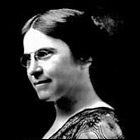| |
 |
|
The
Bright Young Dr. Goldberger
Bored and intellectually restless in private practice in Wilkes-Barre,
Pennsylvania, the young, shy physician joined the United States Marine
Hospital Service, (later the U.S. Public Health Service or PHS) in 1899
at the beginning rank of Assistant Surgeon earning an annual salary of
$1,600. Ironically, the immigrant from central Europe began his public
health service career inspecting immigrants in the port of New York. However,
it was not long before his epidemiological skills earned Goldberger the
reputation of a tenacious and clever epidemic fighter.
Between 1902 and 1906, Goldberger heroically battled epidemic diseases.
He fought yellow fever in Mexico, Puerto Rico, Mississippi, and Louisiana,
contracting the disease himself His efforts earned him a promotion to the
rank of Passed Assistant Surgeon in 1904
and later, an introduction to Mary Farrar, grandneice of Confederate President Jefferson Davis. In 1906, the immigrant Jewish physician from New York's
Lower East Side married the daughter of a wealthy and socially prominent
Episcopalian attorney from New Orleans over the religious objections of
both families.
The young couple from different traditions found common ground in their
belief in science, especially medical science as the instrument of improving
mankind's lot through relieving suffering. Now assigned to the Hygienic
Laboratory in Washington, Joseph Goldberger studied typhoid fever. He
was soon sent to Texas after an outbreak of dengue fever. Once again,
Goldberger contracted what he studied. The same thing happened a third
time when he battled typhus in Mexico.
Goldberger made several important epidemiological discoveries during
this period of his career. In 1909, he published his research on Shamberg's
disease, an ailment characterized by continuous itching and elaborate
skin eruptions similar to those of smallpox. An acarine mite, which infested
wheat and secluded itself in the straw mattresses common among poor city-dwellers,
proved to be the culprit.
Goldberger also collaborated with Dr. John F. Anderson to show that "Brill's Disease" was identical to typhus. He and Anderson also made major breakthroughs in understanding the transmission of typhus and measles. Goldberger was fighting an outbreak
of diphtheria in Detroit in 1914 when the surgeon general asked him to
turn his attention towards the study of pellagra.
Back To Top | Photography Credits
|
|
 |
| Mary Farrar Goldberger |
| |
| |
| |
|
 |

